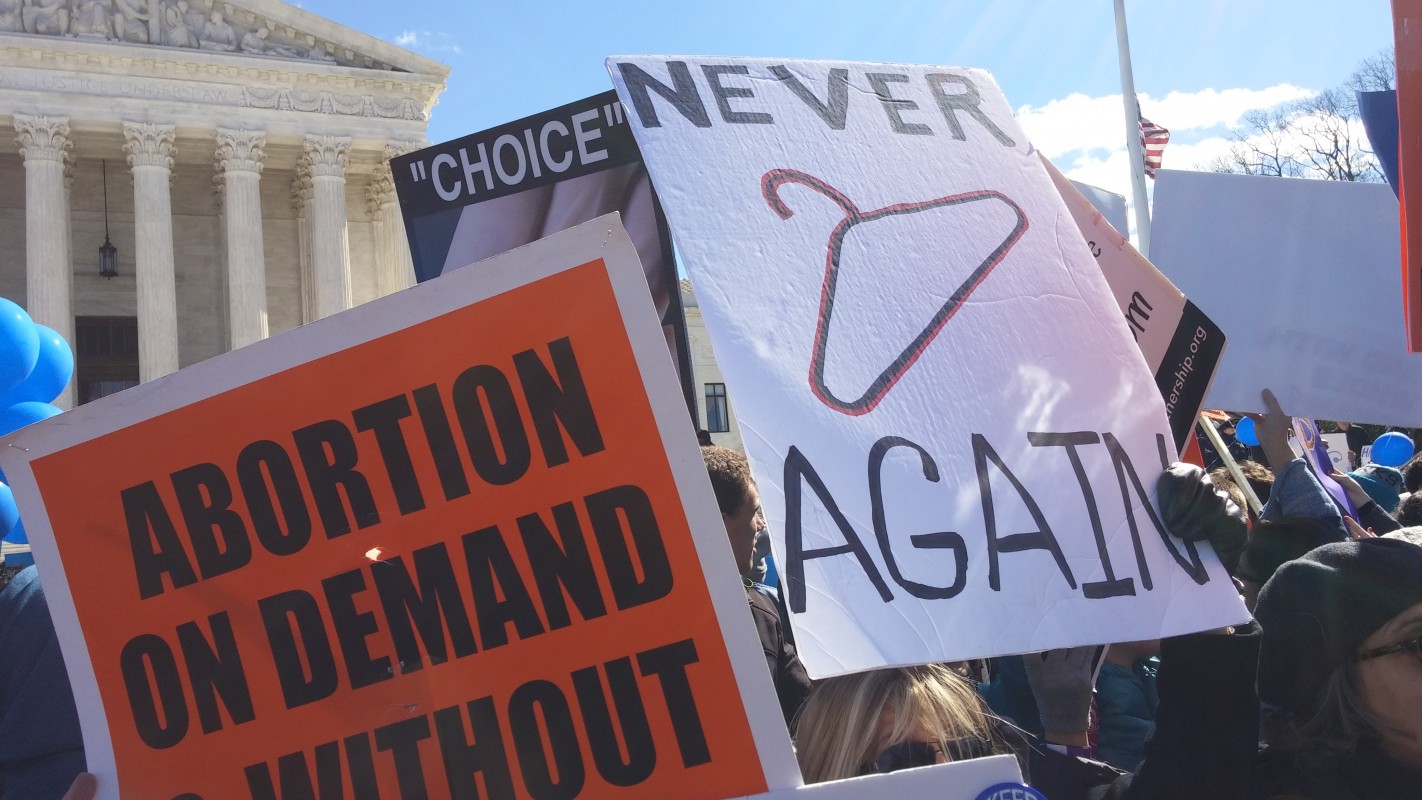U.S. Supreme Court hears oral arguments in potentially landmark abortion rights case

The Supreme Court today heard its first major abortion rights case in several years. At the center of the case, Whole Woman’s Health v. Hellerstedt, is a Texas law that has reduced the number of abortion clinics in the state by more than half. That number could shrink to nine or ten should the Supreme Court uphold the law. With a vacancy on the bench, the court could easily have a four-to-four tie. Reporter Tanya Snyder explains what that could mean.
An estimated 2,000 people came to the Supreme Court Wednesday for what many describe as the most important abortion case to go before the court in 20 years. Some lined up hours before the chambers opened, hoping to witness the oral arguments inside. Others came for the boisterous rally outside, where pro-choice activists vastly outnumbered the other side.
At the center of the case is a Texas law known as HB2.
HB2 first drew national attention in 2013 when Wendy Davis stood in her pink sneakers on the floor of the Texas Senate for 11 hours to filibuster the legislation. Despite Senator Davis’s efforts, HB2 became law and has since shut down more than half of the state’s abortion clinics, mostly due to increased regulations on the facilities and on the doctors performing the procedures.
The case before the Supreme Court Wednesday centered on two aspects of the law.
First, HB2 required abortion clinics to meet the same building and staffing standards as ambulatory surgical centers.
“It needs to be a certain size, it needs to have janitor closets of a certain size, it needs to have a certain number of parking spots, so it’s very expensive just to build it and once it’s built, it’s also much more expensive to run,” explains Julie Rikelman of the Center for Reproductive Rights. “And again you have to go back to the ultimate question of where is the medical benefit of it, and there isn’t any.”
The second thing the law did was to require a doctor who performs abortions to have admitting privileges at a hospital within 30 miles – even though Rickelman says abortions are usually safe procedures with relatively low risk of complications. “Hospitals have many reasons for why they do not give admitting privileges that have nothing to do with the doctor’s competence,” she noted. “For instance, they may not need additional doctors of that specialty, they need doctors of other specialties. It’s a process has nothing to do with whether someone is a good doctor.”
Advocates say if the Supreme Court doesn’t strike down HB2, only 10 clinics will be left in Texas to serve 5.5 million women of reproductive age. All of those clinics are located in urban areas.
Proponents of HB2 argue the law is about protecting women’s health.
Americans United for Life has helped states all around the country pass regulations similar to HB2, known as Targeted Regulation of Abortion Providers – or TRAP laws. Clark Forsyth, the group’s acting president and senior counsel, says these laws “are important for health and safety. They require continuity of care between patients.”
But opponents of HB2 warn the law has had the opposite effect. Dr. Bhavik Kumar is an abortion provider at Whole Woman’s Health, the lead plaintiff in the case. He said the closure of so many clinics has created a backlog, which has forced women to carry their pregnancies for longer and terminate them later.
“Many patients were desperate to access care,” says Kumar. “Wait times for an initial appointment were over 20 days, and more women were having procedures in the second trimester for reasons beyond their control.”
Texas abortion providers who remain in practice have warned of multiple cases of attempted self-induction due to long wait times or patients’ inability to travel long distances. Texas law also mandates wait times between initial visits and abortions, which requires at least two trips to a clinic.
Attorney Stephanie Toti with the Center for Reproductive Rights, who argued the case before the Supreme Court Wednesday, says the law cannot be justified on health grounds – it only exists to restrict women’s access to their constitutional rights.
“Texas abortion clinics have a documented history of safety that goes back for decades,” remarked Toti after presenting oral arguments. “There is absolutely no evidence of any substandard provider in Texas.”
With Justice Antonin Scalia’s death last month, the court is now one justice short, leaving open the very real possibility of a four-to-four tie. A tie would automatically uphold the lower court’s decision, keeping the abortion restrictions in place. So naturally, all eyes were on Justice Anthony Kennedy, the one possible swing vote. Kennedy asked several questions of both sides but didn’t show his hand.
A decision is expected in June.











